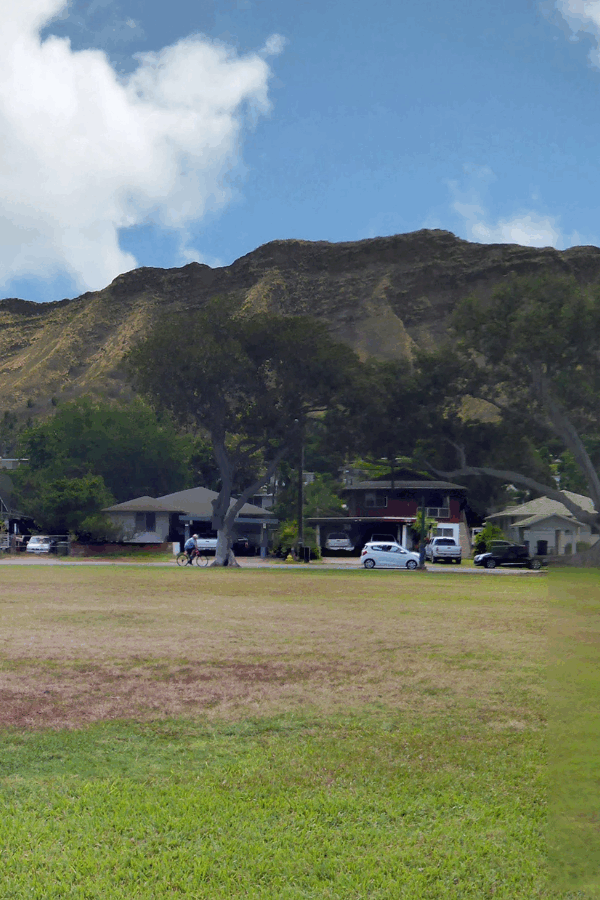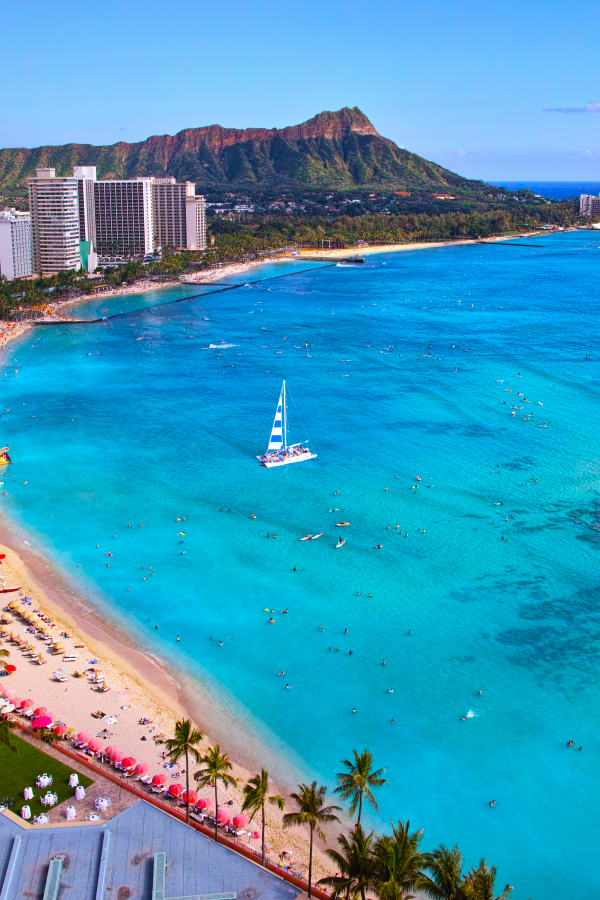Kaena Point State Park is a stunning nature reserve that captures the raw beauty of Hawaii’s landscapes. Located at the westernmost tip of Oahu, this park offers a unique blend of scenic ocean views, rugged cliff faces, and an abundance of native wildlife. The park’s isolated position allows it to serve as a sanctuary for a variety of bird species, and it’s renowned for its hiking trail that culminates at a lighthouse offering panoramic views of the Pacific Ocean. Kaena Point is more than just a park—it’s an invitation to explore and appreciate the untouched side of Hawaii. Let’s embark on this journey and discover this intriguing wonder.
Highlight
- Kaena Point State Park, located at the westernmost tip of Oahu, offers stunning ocean views and a rich biodiversity that attracts nature enthusiasts and bird watchers alike.
- The park hosts the Kaena Point Natural Area Reserve, a critical habitat for a variety of native Hawaiian plants and seabirds.
- A moderately challenging hike leads visitors to the point, rewarding them with glimpses of Hawaiian Monk Seals basking on the shoreline and Albatross nesting in the dunes.
- Despite its raw, untamed beauty, Kaena Point is easily accessible, with two main trailheads originating from both the North Shore and Leeward Coast.
History
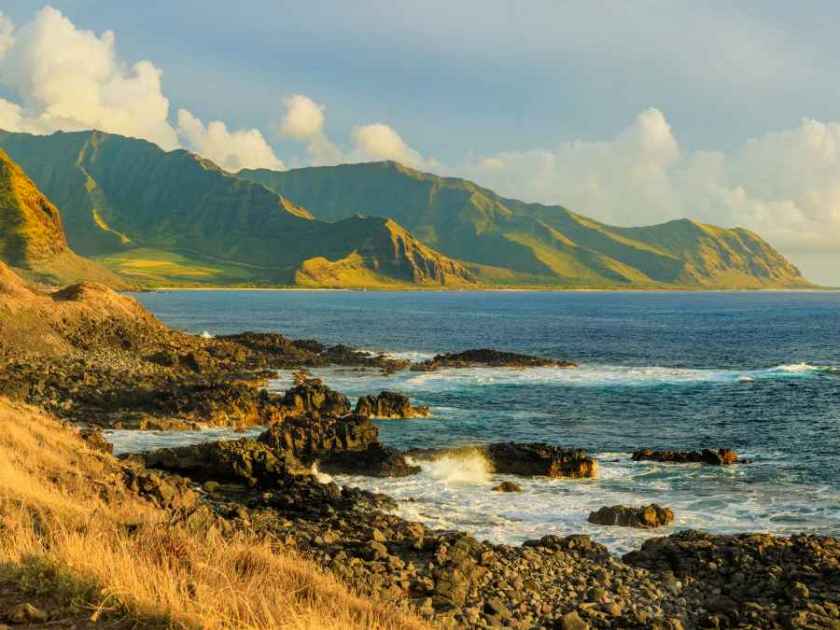
The history of Kaena Point State Park dates back to ancient Hawaii when it was believed to be the “jumping-off” point for souls leaving this world. In Hawaiian, “Kaena” means ‘the heat’. The area got its name from the volcano goddess, Pele, who, according to local folklore, dug her fingers into the earth, creating the hot, arid landscape. Over time, Kaena Point has served numerous roles, from a fishing and farming hub for ancient Hawaiians to a railroad site during the sugarcane era. Archeological evidence also indicates that this area was once a bustling settlement with numerous heiau (traditional Hawaiian temples) and fishing shrines. Ancient Hawaiians relied on the abundant marine resources in the area, practicing sustainable fishing methods and respecting the land and sea’s interconnectedness. The park’s trails offer a glimpse into this past, with ruins of old stone walls and platforms scattered throughout the landscape.
Kaena Point State Park is divided into two sections: Mokule’ia and Keawa’ula, each offering unique attractions. In the Keawa’ula section, thrill-seekers can enjoy a vast sandy beach perfect for board surfing, body surfing (experts only), and refreshing swims during calm summer conditions. For nature enthusiasts, the Mokule’ia section presents sandy and rocky coves, mesmerizing tide pools, expansive dunes, and precious habitats for endangered invertebrates. Due to the destruction of some of the indigenous plant population in the late 1970s, it has been prohibited to use recreational vehicles. The majority of the flora and animals are protected since Ka’ena Point has been designated as a nature reserve since 1983. Today, it stands as a protected state park and a wildlife sanctuary, preserving not just its rich natural splendor, but also its deep-rooted history and cultural significance.
Things To Do
Swimming and Surfing at the Beach
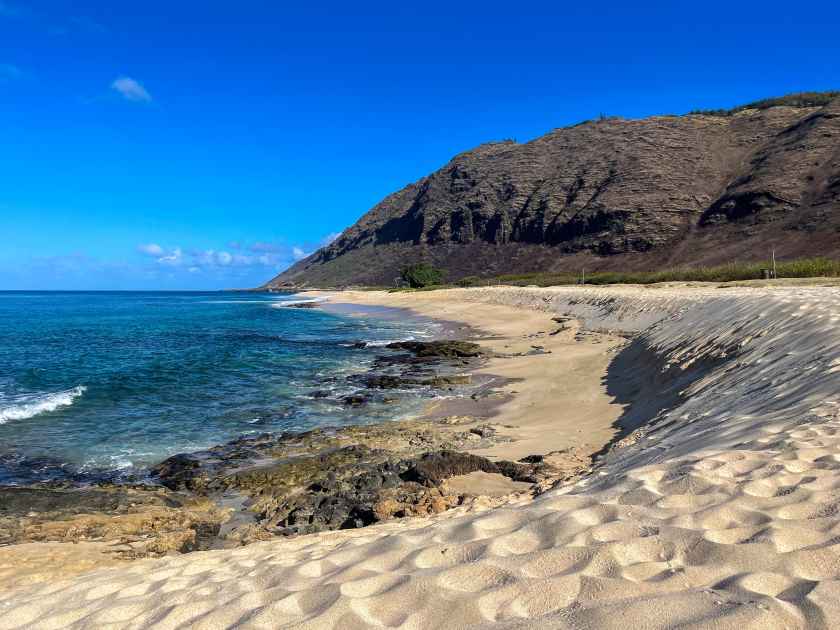
At Kaena Point State Park, your exploration wouldn’t be complete without a trip to the sandy shores of Keawa’ula Bay, located in the park’s Keawaʻula section. Kaena Point State Park is not typically a swimming destination due to strong currents and hidden rocks. However, for the adventurous and experienced swimmer, the crystal clear waters can offer a unique challenge. On days with calm sea conditions, the underwater world of Kaena Point reveals a diverse marine ecosystem teeming with colorful fish and vibrant coral reefs. For a dose of adrenaline, Kaena Point State Park also offers thrilling water activities like board surfing and body surfing. However, due to the area’s strong currents, these activities are recommended only for experienced surfers. Just like surfing, swimming is advised only during the summer when the conditions are considerably calmer and safer. For your convenience and safety, lifeguard services are provided, and a comfort station is available on-site.
Traveler’s Note: As per the NOAA regulations, swimming with, approaching, or remaining within 50 yards of spinner dolphins is strictly prohibited to protect these playful marine creatures. Similarly, for the Hawaiian Monk Seals, visitors are required to maintain a distance of at least 50 feet both on land and in water. These rules are in place to safeguard the animals and their habitats, ensuring they can continue to thrive in this incredible ecosystem
Hiking at Kaena Point State Park
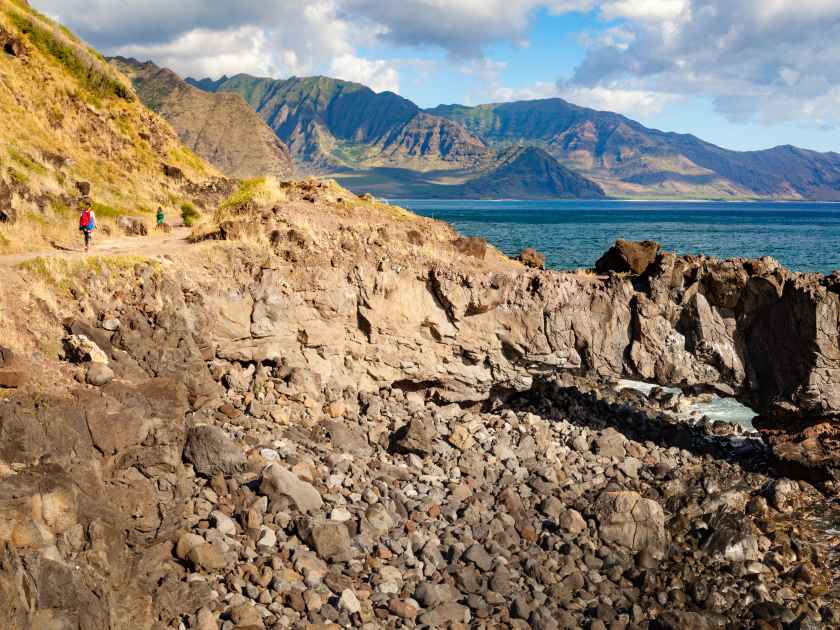
Hiking is one of the most popular activities at Kaena Point State Park and for good reason. The hike to the point from either the North or South section is a 2.7-mile one-way journey, unfolding along a volcanic coastline with an unmatched blend of mountain and ocean views. Kaena Point State Park serves as a gateway to the even more precious Ka‘ena Point Natural Area Reserve settled at the most northwestern point of Oahu. This strategic location further accentuates the park’s allure, making it a cherished starting point for those eager to delve deeper into Hawaii’s natural marvels. As you traverse this trail, you’ll be greeted by the sight of majestic mountains on one side, and the endless expanse of the turquoise Pacific Ocean on the other. Along the trail, you may also stumble upon intricate tide pools teeming with marine life. Among the most spellbinding sights are the graceful sharks and rays, which frequent these tidal pools. The terrain, while rugged in parts, is reasonably flat and navigable, making the trail suitable for both beginner and experienced hikers. The journey culminates at the secluded Kaena Point, where unobstructed views of the ocean offer a rewarding finale.
Fishing at Kaena Point State Park
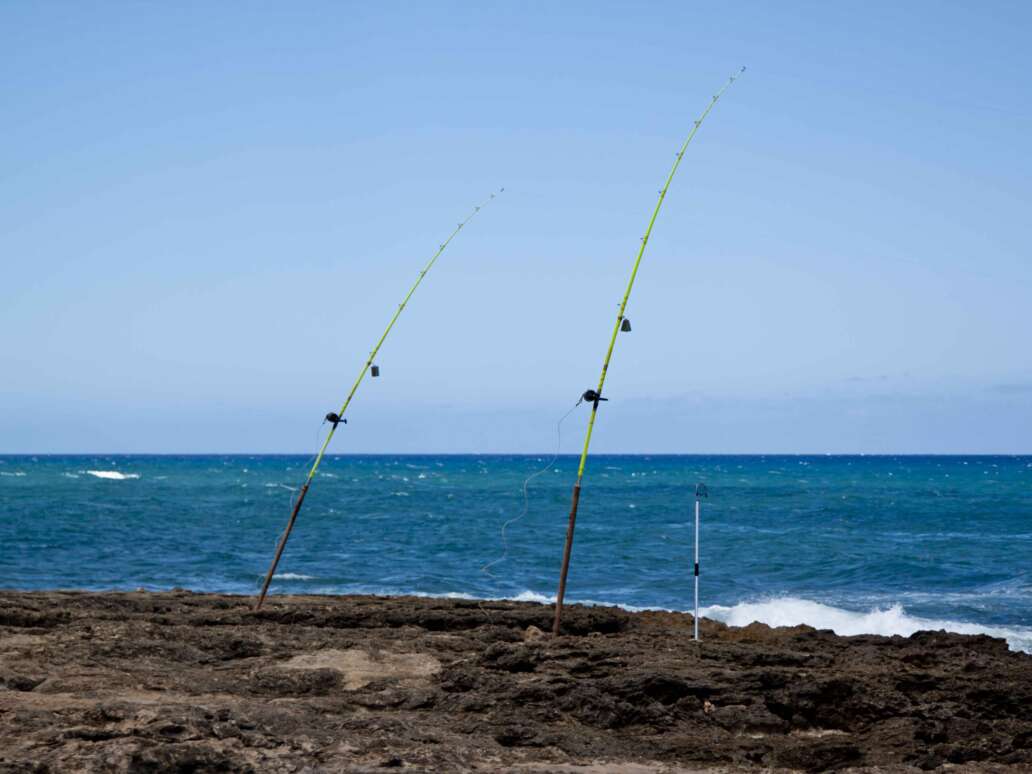
Kaena Point State Park is a popular destination for anglers looking for a unique fishing experience. The park’s pristine coastline offers abundant opportunities to cast a line into the azure Pacific waters, teeming with a variety of marine life. Fishing here allows you to engage with the park’s marine ecosystem while enjoying the stunning scenery. Remember, while the park encourages recreational fishing, it is important to respect the established guidelines to ensure the preservation of marine life. Always adhere to sustainable fishing practices like catch and release, and refrain from fishing in protected areas, ensuring the beauty and diversity of Kaena Point continues for future generations.
Wildlife Viewing
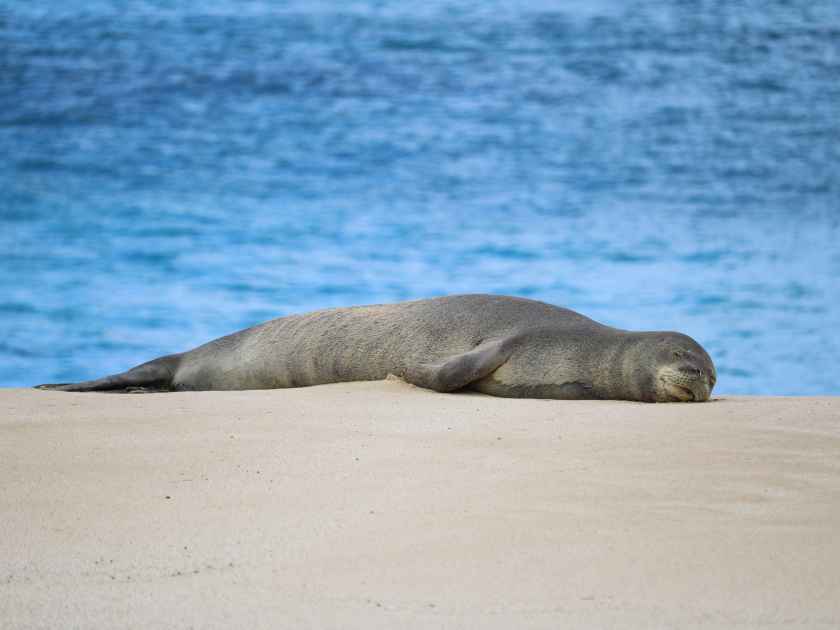
Ka’ena Point State Park is not just a sanctuary for marine life, but also an important refuge for a variety of avian species. The park is home to an array of protected wildlife, from graceful Laysan Albatrosses nesting near the trails to the endangered Hawaiian Monk Seals basking along the rugged shoreline. You may also catch a glimpse of native plants, some of which are endemic to Hawaii. Amidst the vibrant flora, look out for small, colorful creatures like the Hawaiian garden spider, the yellow-faced bee, and the Koa butterfly. From November to May, Kaena Point State Park becomes a magnet for whale enthusiasts. During these months, visitors might be blessed with the awe-inspiring sight of Humpback Whales offshore. The point also serves as a nesting site for several other birds that contribute to its vibrant ecosystem. The Mynah birds, distinguished by their glossy black feathers and yellow eye patches, often fill the air with their varied, melodious calls. Cardinals, known for their striking red plumage and crested heads, add a dash of color to the park’s rich tapestry of life. Several types of doves, with their soft cooing and gentle demeanor, also find solace in the park’s tranquil environment.
Conservation Efforts at Kaena Point State Park
The park’s management has implemented numerous measures to revitalize and protect its unique ecosystem. These include fencing off certain areas to protect nesting birds from predators and limit human interference. The park also engages in active habitat restoration projects to preserve its native flora. An invasive species management program helps to keep the ecological balance in check, ensuring that the diverse native species continue to thrive. Besides, the park educates visitors about the importance of conservation and the role they can play in it, fostering a sense of responsibility and respect for nature. These concerted efforts have paid off, with a noticeable increase in the population of endangered species and the overall richness of the park’s biodiversity.
Park Rules and Regulations
It’s crucial to remember that some activities are not permitted within Kaena Point State Park to ensure the safety and well-being of its unique ecosystem and its visitors. Dogs, for instance, are not allowed within the park boundaries: their presence could disturb wildlife and disrupt their natural behavior. Similarly, drones are prohibited as they can cause stress to animals and birds, and potentially lead to dangerous encounters. Camping is also not allowed in the park, as is lighting ground fires. Adhering to these rules helps maintain the natural splendor of the park for everyone to enjoy.
Always respect and follow the park signs, road signs, and park rules during your visit. These regulations are in place not only for your safety but also to protect the park’s diverse flora and fauna. Kaena Point State Park is a treasure trove of natural wonders that we all share responsibility for preserving. Let’s do our part to ensure this gem continues to shine for generations to come.
Read more about the park rules here.
Tips for Visiting
- Plan your visit: Check the weather forecast before heading out and it’s always a good idea to start your hike early in the day to avoid the afternoon sun.
- Stay hydrated: Be sure to bring plenty of water as there are no water facilities on the trail.
- Dress appropriately: Wear comfortable clothing and sturdy shoes suitable for hiking. Don’t forget to apply sunscreen and wear a hat for protection against the sun.
- Respect the wildlife: Maintain a safe distance from wildlife and do not feed or attempt to touch them.
- Leave no trace: Carry a trash bag with you and make sure to take all of your trash with you when you leave.
- Stay on the trail: Straying from the trail can be dangerous and can also harm the park’s delicate ecosystems.
- Swim with caution: If you choose to swim or snorkel, be aware that there are no lifeguards on duty and the currents can be strong.
- Bring binoculars: If you’re interested in bird-watching or spotting marine life, binoculars can enhance your experience.
- Bring a first aid kit: Since there are no telephones in the park, it’s wise to bring a basic first aid kit for emergencies. This should include bandages, antiseptic wipes, tweezers, medical tape, and any personal medication you may need. Remember, safety is a priority when exploring nature’s bounty.
- Pack a picnic: There are no dining facilities in the park, so pack a picnic to enjoy amidst the spectacular natural beauty
- Enjoy the journey: Take your time and enjoy the breathtaking views, fascinating wildlife, and the unique peace and tranquility of Kaena Point State Park.
Frequently Asked Questions (FAQs)
Kaena Point State Park is best known for its natural beauty, including stunning ocean views, rugged coastline, and diverse wildlife
Kaena Point State Park is located at the westernmost tip of Oahu, Hawaii. It lies between the North Shore and the West Side of the island, offering a remote and beautiful escape from the city.
Yes, the park features the Kaena Point Trail, a moderately challenging hike that rewards visitors with breathtaking coastal views and wildlife sightings. It’s a favorite among nature lovers and bird watchers.
Visitors to Kaena Point State Park can expect to see a variety of wildlife, including the Laysan Albatross, Hawaiian Monk Seal, and other native species.
Yes, Kaena Point State Park is open year-round, although access may be restricted during certain weather conditions for safety reasons. Always check the park’s official website or local news for the latest information.
No, there is no entrance fee for Kaena Point State Park, making it a budget-friendly choice for nature lovers visiting Oahu.
How To Get There
Directions
Kaena Point State Park is situated at the westernmost tip of O’ahu. To reach the park, visitors can take the Farrington Highway and follow it to its terminus at the park entrance. There are two main access points to the park – from the Mokule’ia side to the north and from the Wai’anae side to the south.
If you’re coming from the Mokule’ia side, head west on Highway 930 from Haleiwa. The highway ends at the parking lot where the Kaena Point trail begins. From the Wai’anae side, follow Highway 93 west. The road ends at Yokohama Bay, where you will find the trailhead on the mountainside of the road.
Pro Tip: Due to the uneven terrain, it is not advised to go beyond the macadamized road from either direction (Arrigoni 4). After parking, you would continue on foot from either direction for the remaining distance. While the park is open seven days a week from sunrise to sunset, please note that the parking lots at both access points are not gated, so be sure to finish your visit to the park and return to your vehicle before dark.
Accessibility
The trail is relatively flat and negotiable for most visitors, though it’s unpaved and can be rough in places, especially after rain. It’s best to wear sturdy footwear and bring plenty of water, sun protection, and snacks. Those with mobility concerns should note that the terrain may be challenging in places. There are no facilities or services available along the trail, including restrooms and water, so be sure to come prepared.
Pro Tip: Public transportation to Kaena Point State Park is limited. TheBus, O’ahu’s public transportation system, has a stop at Yokohama Bay, although it requires a bit of hiking from the nearest bus stop to the park entrance. It can be a bit rough, so a vehicle with high clearance is recommended. Therefore, a private vehicle is the most convenient mode of transportation to reach Kaena Point State Park.
Important Note: Acquiring a Vehicle Access Special Use Permit is needed to drive into Ka‘ena Point State Park Reserve, Mokuleʻia Section. Vehicle use in the area was previously unregulated, but now requires the permit. Permit owners receive the combination of the lock on the gate via the internet and must display both a paper copy of the permit and a valid decal on their vehicle. The current decal must be affixed to the rear bumper or a similar visible location from behind. The Kaʻena Point Vehicle Access Permit allows access to designated roads in the permitted section provided on the KP Designated Road Map. During closed park hours, permit holders are only allowed to enter and transit through the entrance of the park and must not stop or stand in this area.
Kaena Point State Park is a Must-visit for Any Travel Enthusiast!
Its remarkable blend of natural beauty, abundant wildlife, and cultural significance provides a unique and enriching experience unlike any other. Visitors often laud the park for its breathtaking vistas, the thrill of spotting a rare albatross or monk seal, and the sense of tranquility that comes from being immersed in such a pristine environment. Whether you’re an adventure-seeker, a nature lover, or simply someone looking to escape the hustle and bustle of city life, Kaena Point State Park promises an unforgettable journey that leaves you yearning for more.


